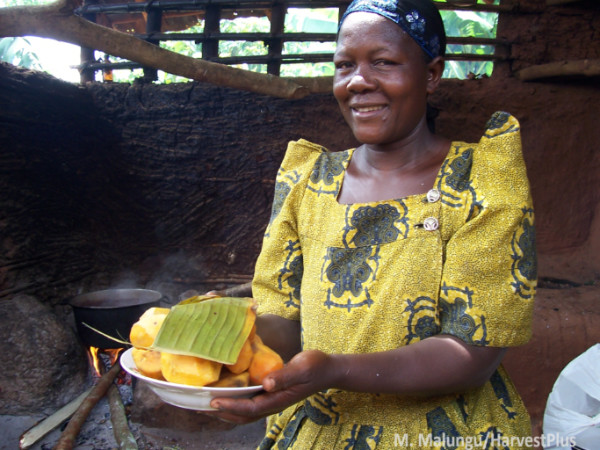
Using evidence to inform the scale-up of biofortified orange sweet potato in Uganda

Context
Deficiencies of micronutrients such as vitamin A, zinc and iron can cause diseases or exacerbate them. More than two billion people suffer from micronutrient malnutrition, known colloquially as hidden hunger. In Uganda, vitamin A deficiency is a health challenge affecting an estimated 28 per cent of preschool children.
The international organisation HarvestPlus has been promoting biofortified staple crops to improve the diets of people living in poverty. HarvestPlus is jointly administered by the International Center for Tropical Agriculture and the International Food Policy Research Institute. Between 2007 and 2009, HarvestPlus and its NGO partners distributed biofortified orange sweet potato (OSP) to households in three districts. They also provided nutritional training on the benefits of consuming vitamin A-enriched OSP, particularly for women and children. Research teams, led by the International Food Policy Research Institute, carried out two impact evaluations to assess OSP’s health impacts and farmers’ sustained adoption of it. The collaboration between the research and implementation teams ensured evidence would inform HarvestPlus’s evolving programming.
Evidence
The first impact evaluation, completed in 2010, found that the vitamin A status of deficient children improved after they consumed OSP. The second impact evaluation, which was supported by 3ie and completed in 2015, showed that four years after HarvestPlus distributed OSP, farmers’ adoption and cultivation of it had stabilised, at approximately 50 per cent, in two out of three districts. Promoting OSP cultivation was likely to be more sustainable and cost-effective in communities where the conventional sweet potato was already a major crop. The areas that showed sustained adoption had a comparative advantage for both growing the crop and consuming it.
Evidence impacts
Type of impact: Change policies or programs
Decision makers use findings from an evaluation or systematic review to adjust their programming to fix targeting, cash transfer amounts, training modules or other factors that inhibit the policy or programme’s ability to achieve its intended impacts.
This is one of 3ie’s seven types of evidence use. Impact types are based on what we find in the monitoring data for an evaluation or review. Due to the nature of evidence-informed decision-making and action, 3ie looks for verifiable contributions that our evidence makes, not attribution.
Read our complete evidence impact typology and verification approach here.
Close windowThe evidence informed USAID’s decision to scale up distribution of OSP as part of its Developing and Delivering Biofortified Crops activity. The project was funded through the US government’s Feed the Future initiative. With this additional support, HarvestPlus distributed OSP and iron-fortified beans amongst 409,711 households in 13 districts between 2012 and 2016. This was a big jump from 2007, when OSP had been distributed amongst 10,000 households in three districts.
The impact evaluation evidence has also informed HarvestPlus’s approach to working with farmers’ groups and getting them to share biofortified OSP vines with other farmers. The diffusion and social network approach, explored in the impact evaluations, has offered HarvestPlus an effective way of distributing these vines widely. The results have also offered some important pointers for HarvestPlus on potential criteria for targeting the intervention in different areas.
Type of impact: Improve the culture of evidence use
When decision makers or implementers demonstrate positive attitudinal changes towards evidence use or towards information the research team provides. Examples include strengthening monitoring and evaluation systems, increasing understanding of evidence and openness to using it, integrating these systems more firmly into programming or commissioning another evaluation or review.
This is one of 3ie’s seven types of evidence use. Impact types are based on what we find in the monitoring data for an evaluation or review. Due to the nature of evidence-informed decision-making and action, 3ie looks for verifiable contributions that our evidence makes, not attribution.
Read our complete evidence impact typology and verification approach here.
Close windowGlobal advocacy that is grounded in research has helped HarvestPlus champion the cause of biofortification. HarvestPlus decided to commission another impact evaluation to compare different cost-effectiveness strategies for promoting the sustained distribution and adoption of biofortified crops as part of this scaled-up version of the project.
‘As someone who is involved in in-house research as well as implementation, my job was to translate English into English – because the language that implementers speak is different from the language that researchers speak. Researchers want to do things one way and implementers want to do them another way. You have to learn to make those trade-offs and compromises.' – Anna-Marie Ball, head of Africa Strategic Alliances, HarvestPlus
Suggested citation
International Initiative for Impact Evaluation (3ie), 2019. Using evidence to inform the scale-up and adoption of biofortified orange sweet potato in Uganda [online summary], Evidence Impact Summaries. New Delhi:3ie.
Evidence impact summaries aim to demonstrate and encourage the use of evidence to inform programming and policymaking. These reflect the information available to 3ie at the time of posting. Since several factors influence policymaking, the summaries highlight contributions of evidence rather than endorsing a policy or decision or claiming that it can be attributed solely to evidence. If you have any suggestions or updates to improve this summary, please write to influence@3ieimpact.org